Collin Morgan takes us on a tour of a museum dedicated to one of the American auto industry’s most historical orphan brands.
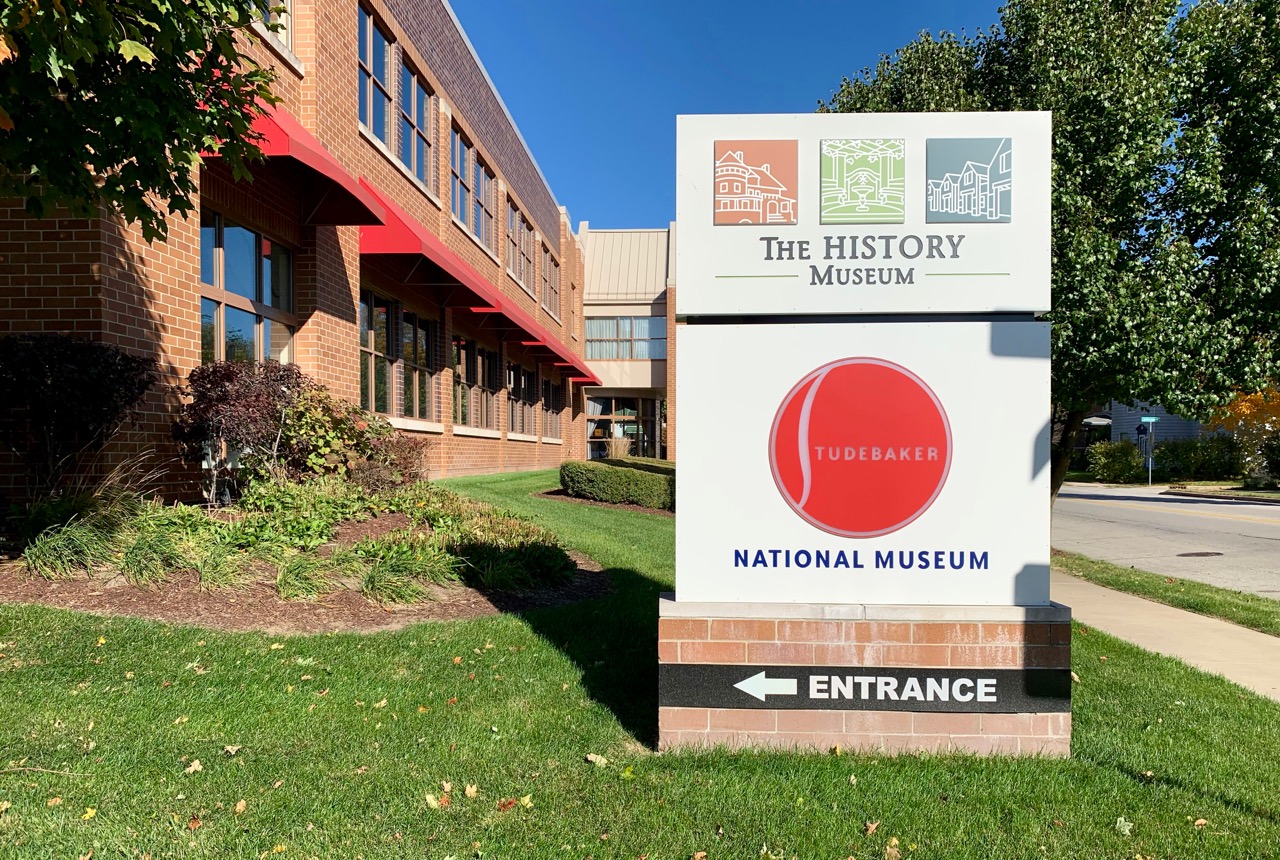
 South Bend, IN is located in a geographical region of the Midwest apathetically known as “The Armpit of America”, or “The Rust Belt”. This corridor of cornfields and smokestacks stretches from Chicago to Pittsburgh, and contains once wealthy industrious cities such as Gary, Detroit and Cleveland. It’s also the home of the SOUTH BEND: STUDEBAKER NATIONAL MUSEUM. The automobile was a vital factor in the rise of local manufacturing, and its factories once pumped out millions of cars!
South Bend, IN is located in a geographical region of the Midwest apathetically known as “The Armpit of America”, or “The Rust Belt”. This corridor of cornfields and smokestacks stretches from Chicago to Pittsburgh, and contains once wealthy industrious cities such as Gary, Detroit and Cleveland. It’s also the home of the SOUTH BEND: STUDEBAKER NATIONAL MUSEUM. The automobile was a vital factor in the rise of local manufacturing, and its factories once pumped out millions of cars!
The decline of jobs hit The Rust Belt mercilessly, and South Bend took a major hit. I drove through downtown and saw the outer ring of the city littered with the familiar struggles of many Midwest cities: massive abandoned concrete lots, faded brick buildings, and potholes big enough to fall into.
However, once I kept cruising down Lincoln Way, things started to change. Fiery maples topped neighborhoods, modern buildings replaced the defunct structures of old, and friendly smiles from residents shone cheerfully through the crisp fall breeze. I pulled into the parking lot of my destination optimistically, mirroring the city surrounding it.
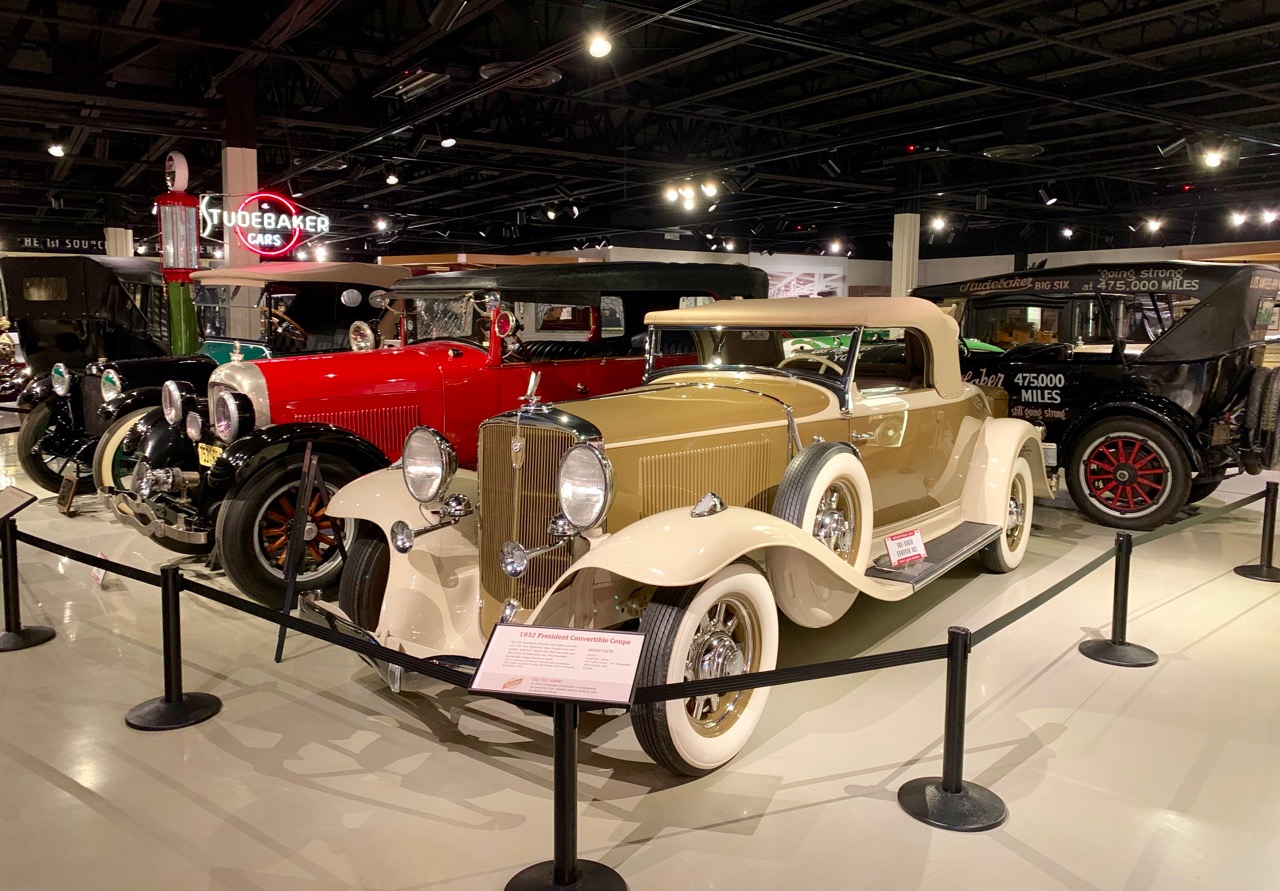 The Studebaker Museum is situated in an old neighborhood, right in the middle of multiple mansions. I was amazed at the surrounding wealth, compared to what I had already seen. Built in 2005, the Museum shares space with the History Museum, and is a classy brick edifice.
The Studebaker Museum is situated in an old neighborhood, right in the middle of multiple mansions. I was amazed at the surrounding wealth, compared to what I had already seen. Built in 2005, the Museum shares space with the History Museum, and is a classy brick edifice.
Inside, I was blown away at the extensive collection. Three stories of history were jam packed with pristine Studebakers, plaques detailing fascinating information dotted the rooms, and classic neon signs glinted off freshly buffed paint. At the end of the main gallery, a proud glimmering Studebaker South Bend greets you.
The middle floor consists of the origins of Studebaker as a wagon manufacturer. Started in 1852 by Henry and Clement Studebaker, the company grew rapidly, eventually to the point where nearly half of the wagons used during the height of westward expansion were Studebakers. Their wagons were proud and highly desirable, boasting that “The Sun Always Shines on the Studebaker Wagon”. A few presidents, including Benjamin Harrison, Ulysses S. Grant, and William McKinley owned Studebakers. In the museum was a stately barouche, and was the last vehicle President Abraham Lincoln rode in alive as it transported him to Ford’s Theater.
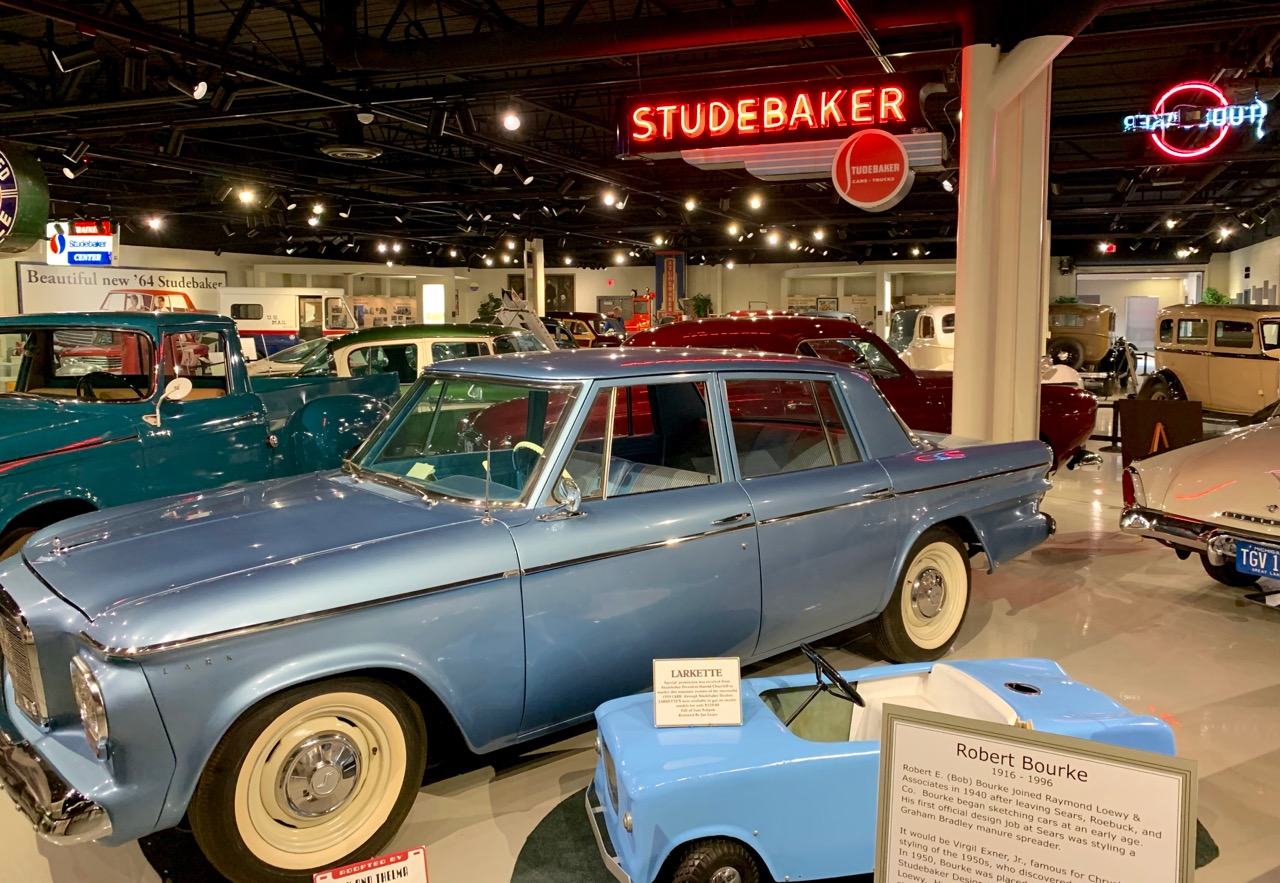 Once Studebaker hesitantly transitioned from horse-drawn carriages to automobiles, they tested out motorsports to promote their models. One of the more successful tactics they utilized was endurance racing, and set some very impressive records for the time, showcasing the durability and reliability of their cars.
Once Studebaker hesitantly transitioned from horse-drawn carriages to automobiles, they tested out motorsports to promote their models. One of the more successful tactics they utilized was endurance racing, and set some very impressive records for the time, showcasing the durability and reliability of their cars.
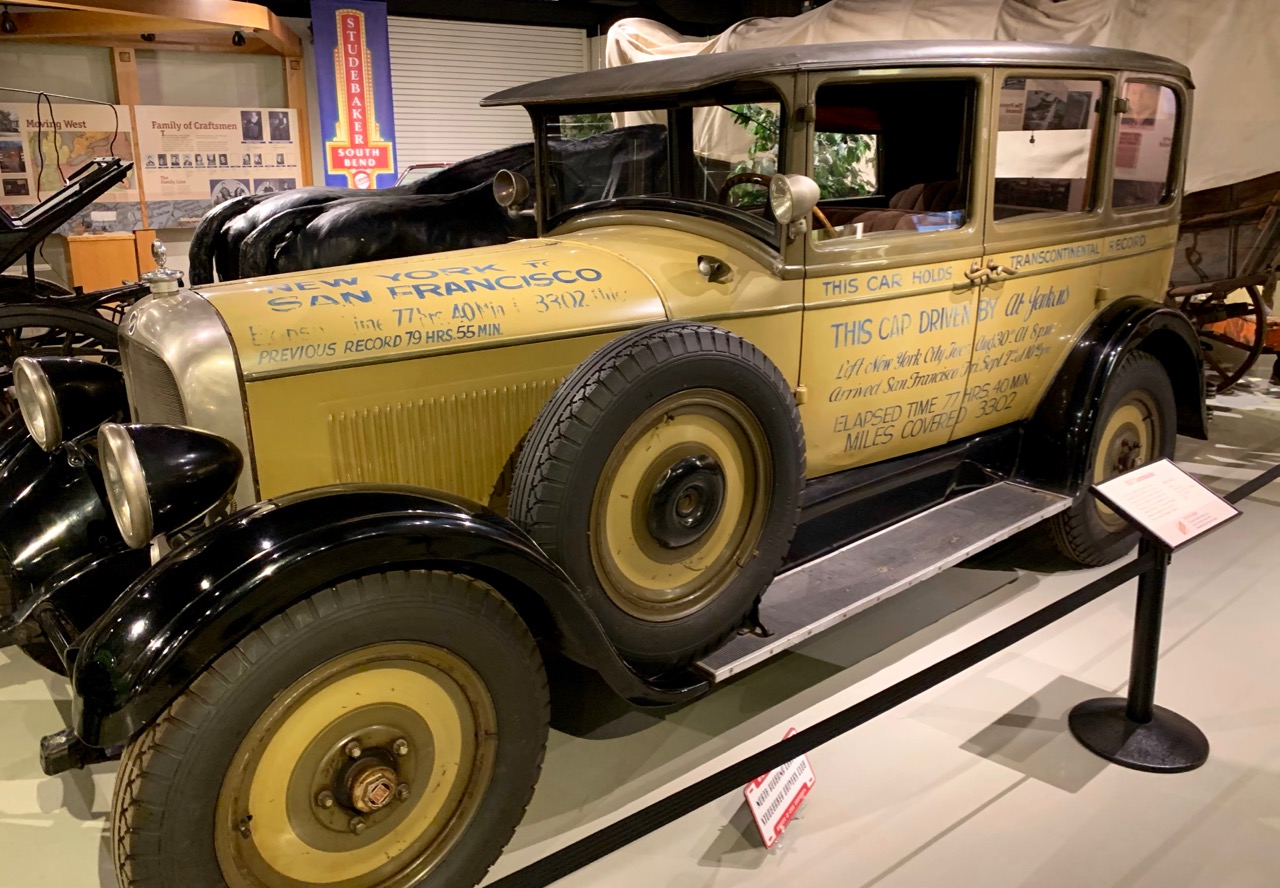 David Abbot Jenkins drove this ‘27 Commander sedan from New York to San Francisco in 77 hours and 40 minutes, covering 3,302 miles and beating the previous record by an hour. As Studebaker moved through the pre-Great Depression era, the cars grew along with the price tags. The museum contained some stunning examples, such as this ‘32 Studebaker President, below, which won a First in Class at Pebble Beach.
David Abbot Jenkins drove this ‘27 Commander sedan from New York to San Francisco in 77 hours and 40 minutes, covering 3,302 miles and beating the previous record by an hour. As Studebaker moved through the pre-Great Depression era, the cars grew along with the price tags. The museum contained some stunning examples, such as this ‘32 Studebaker President, below, which won a First in Class at Pebble Beach.
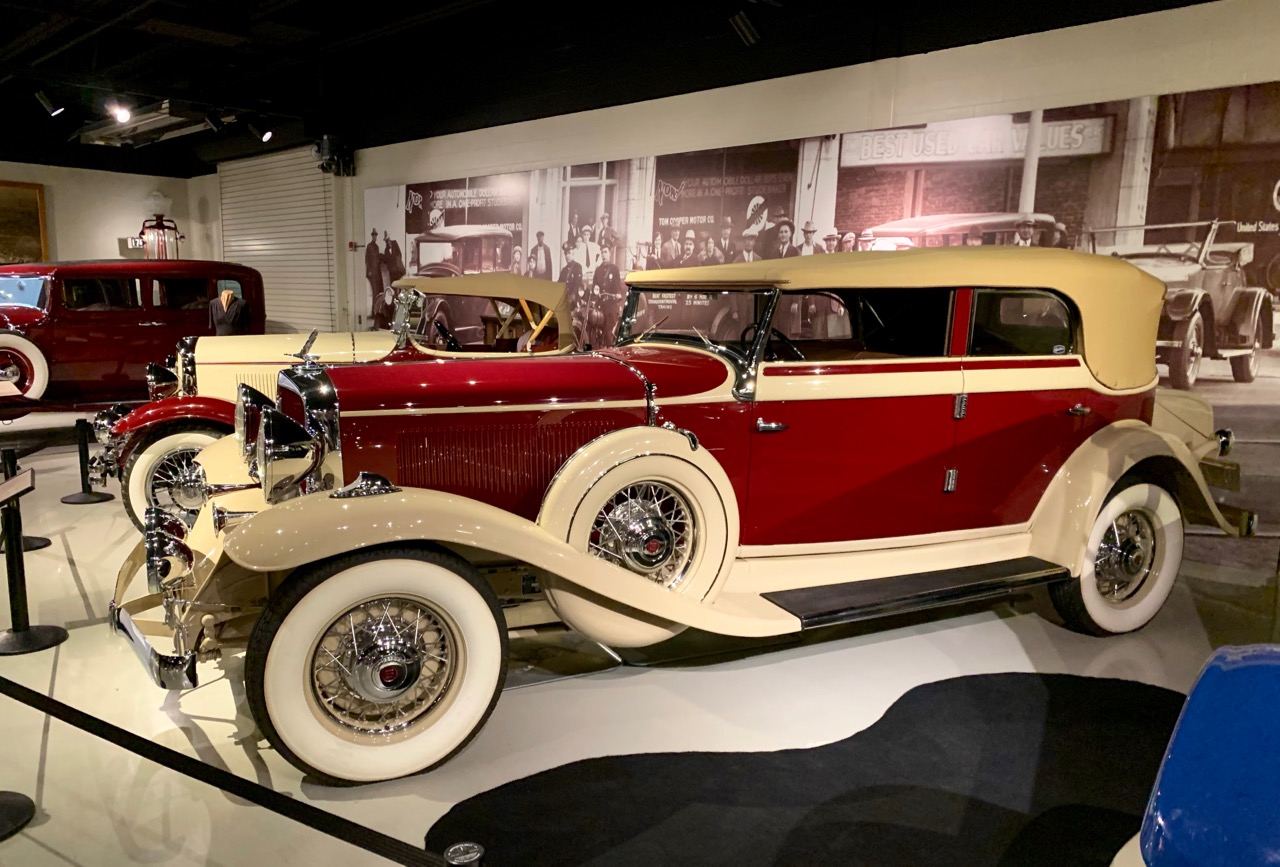 Moving up to the second floor, I was greeted by the familiar styles of the post-World War II automotive era. Curvy lines, circle headlights, and oodles of chrome dominated here like many other American cars during this period. It was a time for hope and optimism, and the people wanted something fresh and unique, with Studebaker being one of the most ambitious automotive manufacturers.
Moving up to the second floor, I was greeted by the familiar styles of the post-World War II automotive era. Curvy lines, circle headlights, and oodles of chrome dominated here like many other American cars during this period. It was a time for hope and optimism, and the people wanted something fresh and unique, with Studebaker being one of the most ambitious automotive manufacturers.
This massive room also consisted of the persistent buzz from the numerous neon signs hanging over the collection. 1950 was the peak year for Studebaker production – 343,166 vehicles. There was a staggering number of cars up here, so I’ll pick out a few of my favorites: SOUTH BEND: STUDEBAKER NATIONAL MUSEUM.
 This ‘53 Champion Starliner hardtop, sporting that unique three-point emblem, was promptly changed after an official complaint from Mercedes-Benz. To this day, the Starliner is still referred to as one of the most beautiful automobiles ever produced. Kudos to Raymond Loewy and Studebaker’s design team for this period masterpiece.
This ‘53 Champion Starliner hardtop, sporting that unique three-point emblem, was promptly changed after an official complaint from Mercedes-Benz. To this day, the Starliner is still referred to as one of the most beautiful automobiles ever produced. Kudos to Raymond Loewy and Studebaker’s design team for this period masterpiece.
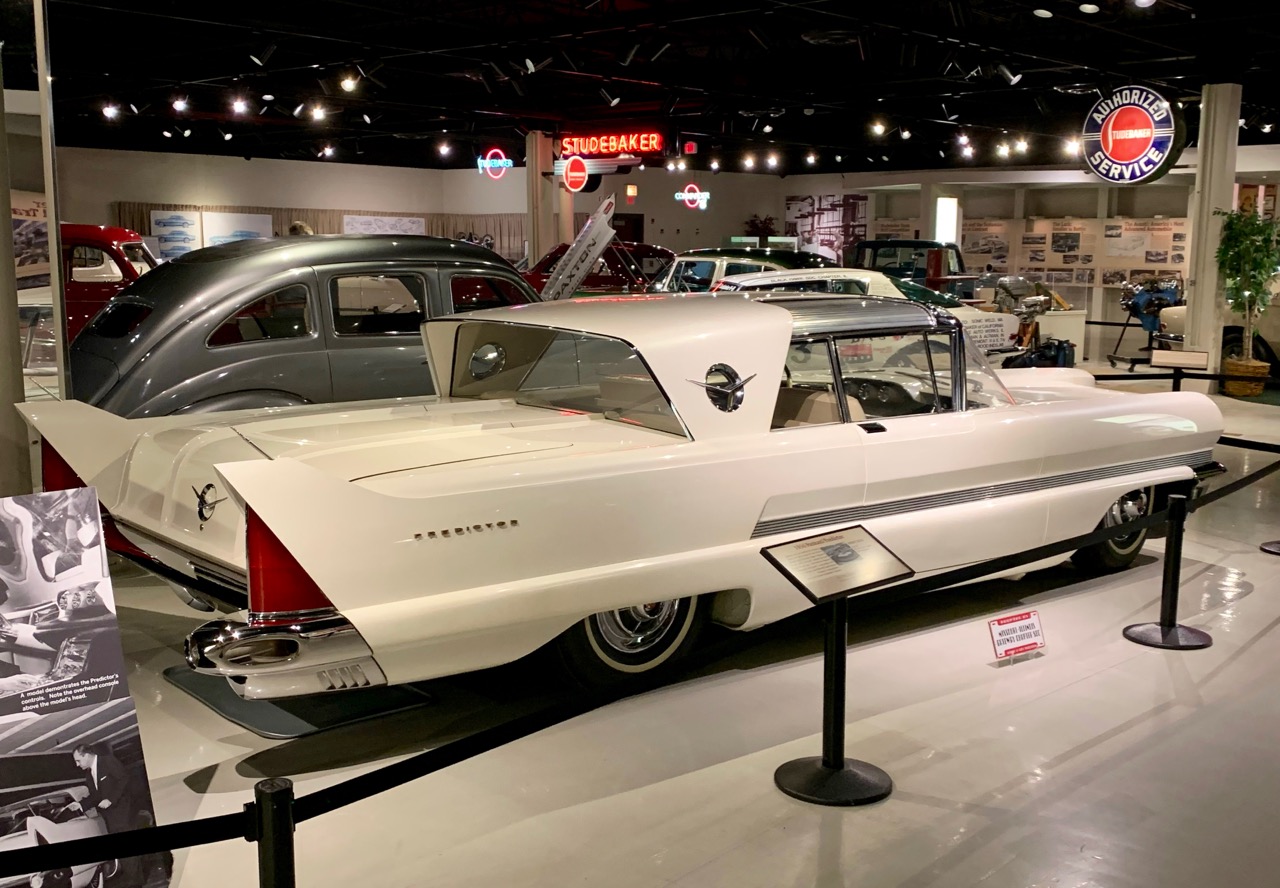 Declining sales in 1954 forced Studebaker to buy out Packard to try and revitalize both companies’ production. This is the ‘56 Packard Predictor concept that wowed auto show visitors. Although never produced, many of its design cues can be spotted on later models from other manufacturers.
Declining sales in 1954 forced Studebaker to buy out Packard to try and revitalize both companies’ production. This is the ‘56 Packard Predictor concept that wowed auto show visitors. Although never produced, many of its design cues can be spotted on later models from other manufacturers.
 The ‘57 Golden Hawk was powered by a 275 horsepower V8, and was a serious performance vehicle in its day. This example is a limited edition Golden Hawk 400, one of 41 ever made. The 400s boasted potent V8 performance plus hand-buffed leather and special paint.
The ‘57 Golden Hawk was powered by a 275 horsepower V8, and was a serious performance vehicle in its day. This example is a limited edition Golden Hawk 400, one of 41 ever made. The 400s boasted potent V8 performance plus hand-buffed leather and special paint.
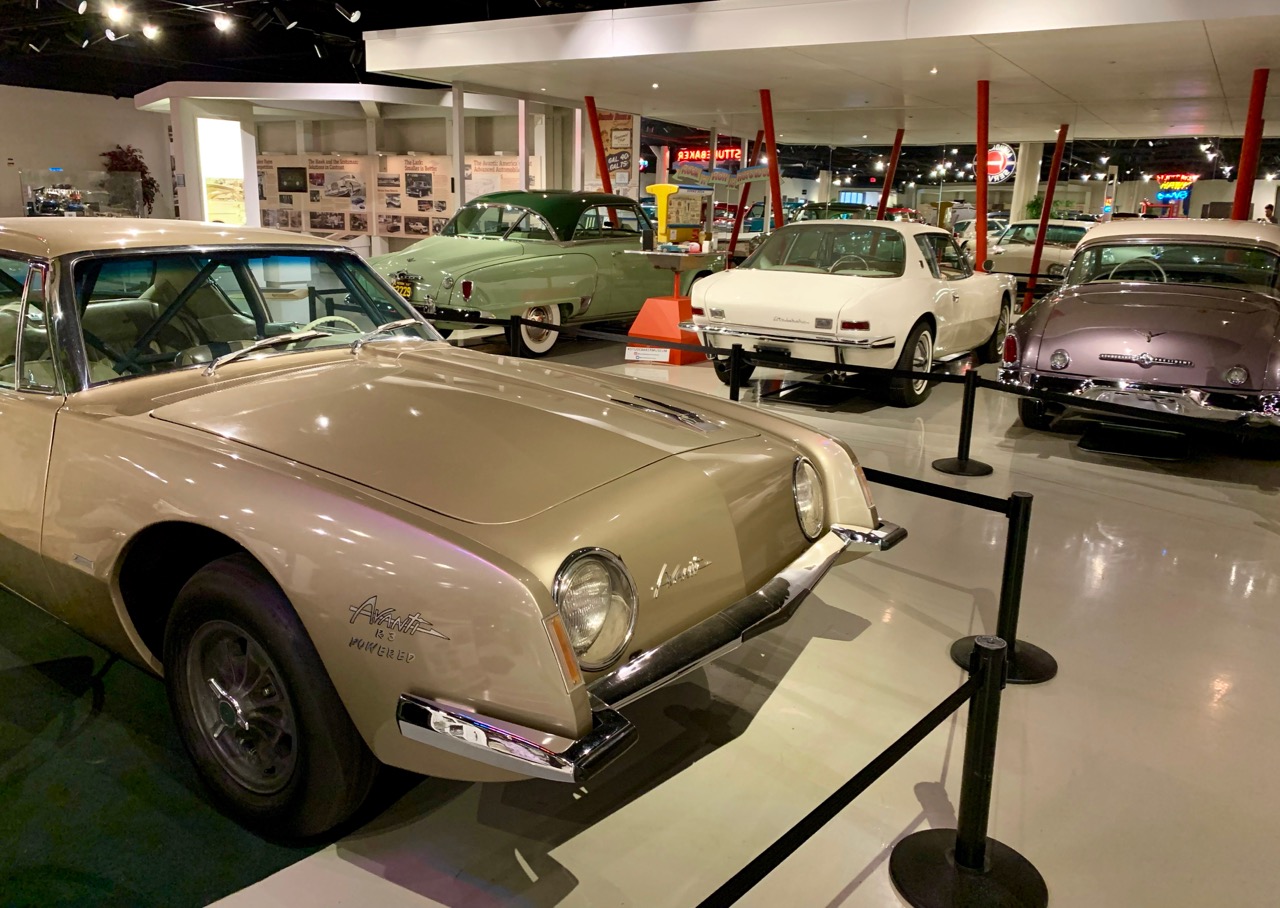 Studebaker’s instantly recognizable Avanti debuted in 1962 at the Indianapolis 500, and was an immediate hit. The Avanti’s fiberglass body, disc brakes, built-in roll bar, and seat belts came standard. Unfortunately, production delays and complications killed this beautiful vehicle. It was a true American GT and set records on the Bonneville Salt Flats.
Studebaker’s instantly recognizable Avanti debuted in 1962 at the Indianapolis 500, and was an immediate hit. The Avanti’s fiberglass body, disc brakes, built-in roll bar, and seat belts came standard. Unfortunately, production delays and complications killed this beautiful vehicle. It was a true American GT and set records on the Bonneville Salt Flats.
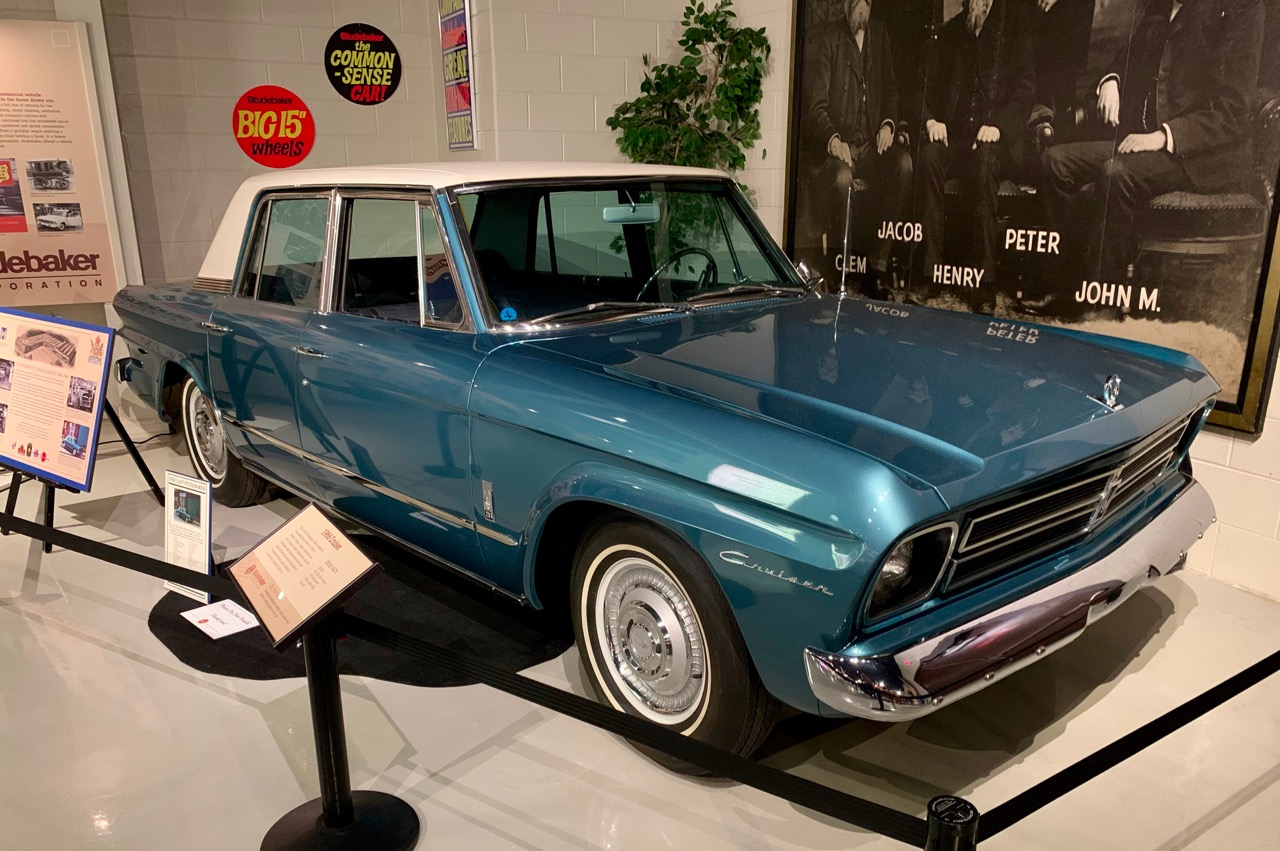 This ‘66 Studebaker Cruiser is the very last Studebaker to roll off of the assembly line. It was completed in Ontario, Canada on March 17, 1966. On December 9, 1963, Studebaker announced that the South Bend production plant would close its doors for good.
This ‘66 Studebaker Cruiser is the very last Studebaker to roll off of the assembly line. It was completed in Ontario, Canada on March 17, 1966. On December 9, 1963, Studebaker announced that the South Bend production plant would close its doors for good.
 On the bottom floor is a smaller holding room for the museum’s extra cars, along with the restoration garage. There were still some fascinating examples, even though they weren’t on the showroom floor. This is the ‘51 Commander from the Muppet Movie. The car was uniquely outfitted with rear controls mounted in the trunk so the puppeteers had the necessary space up front to make the puppets drive the car.
On the bottom floor is a smaller holding room for the museum’s extra cars, along with the restoration garage. There were still some fascinating examples, even though they weren’t on the showroom floor. This is the ‘51 Commander from the Muppet Movie. The car was uniquely outfitted with rear controls mounted in the trunk so the puppeteers had the necessary space up front to make the puppets drive the car.
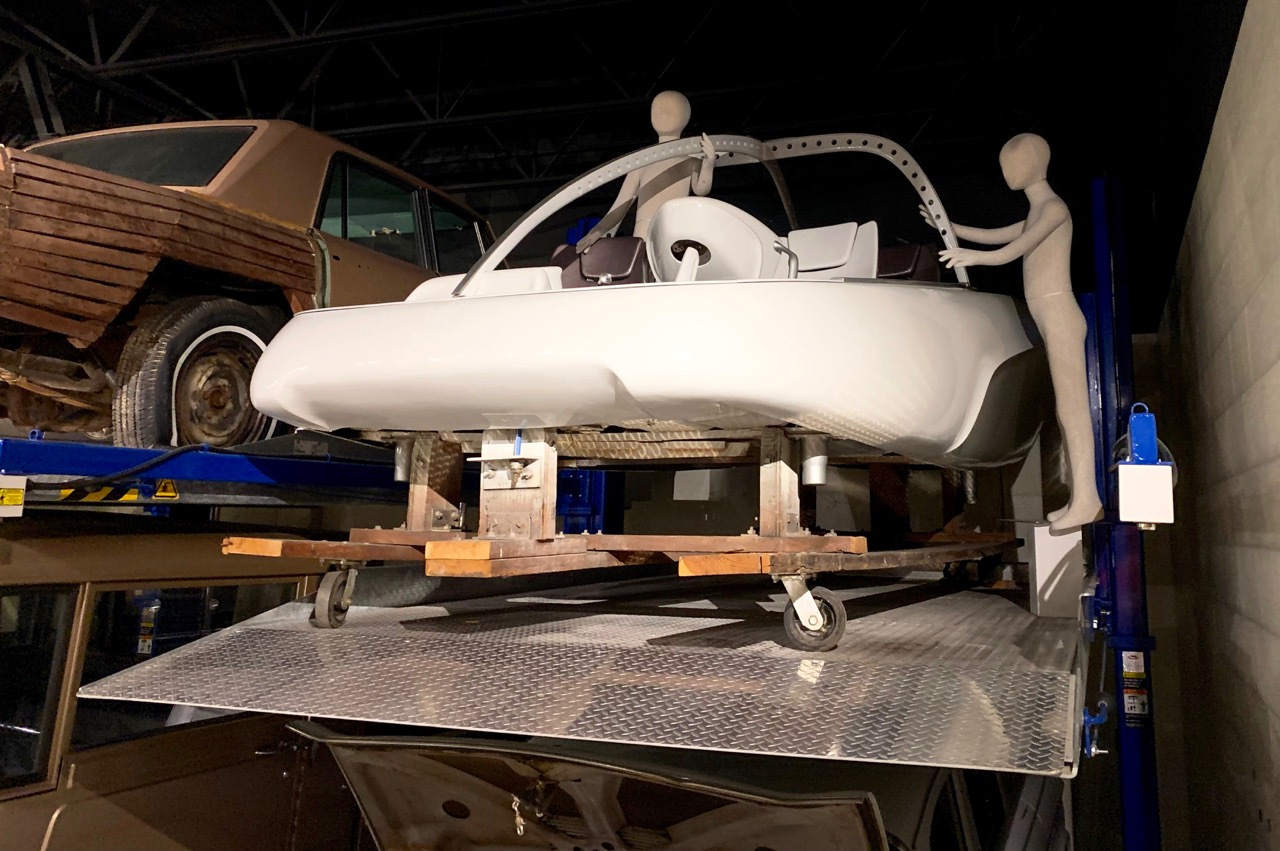 Up top, surrounded by mannequins, sits the Astral, designed in the late-1950s to represent the future of transportation. According to the plaque, either “atomic power” or “ionic beams emanating from a higher source” powered it. You can’t tell me Studebaker was boring after that!
Up top, surrounded by mannequins, sits the Astral, designed in the late-1950s to represent the future of transportation. According to the plaque, either “atomic power” or “ionic beams emanating from a higher source” powered it. You can’t tell me Studebaker was boring after that!
As I re-entered the main gallery, I took it all in. The vibe from the entire museum was that of old glory, ambitious advances, simpler times, and personified automobiles. Studebaker was stately, proud, and didn’t hold anything back. The museum captures their image perfectly. I admire that about Studebaker. Who couldn’t?
Words & Photos: Collin Morgan
For more information on the SOUTH BEND: STUDEBAKER NATIONAL MUSEUM, please visithttps://studebakermuseum.org/
